Dining Consumption Analysis in a Restaurant Context Report
VerifiedAdded on 2022/09/14
|7
|1527
|43
Report
AI Summary
This report provides an analysis of dining consumption within a restaurant context, focusing on customer satisfaction and service quality. It synthesizes findings from four articles, exploring common and differing themes related to customer expectations, the impact of technology, and the role of various factors like food quality, environment, and staff behavior. The report highlights the importance of understanding customer needs, the limitations of existing research, and potential directions for future studies, including the development of strategies to enhance customer satisfaction and loyalty. The report also includes a detailed reference list of the articles reviewed, classifying them by research methodology and providing a comprehensive overview of the field. This report is a valuable resource for students studying business research methods and hospitality management.
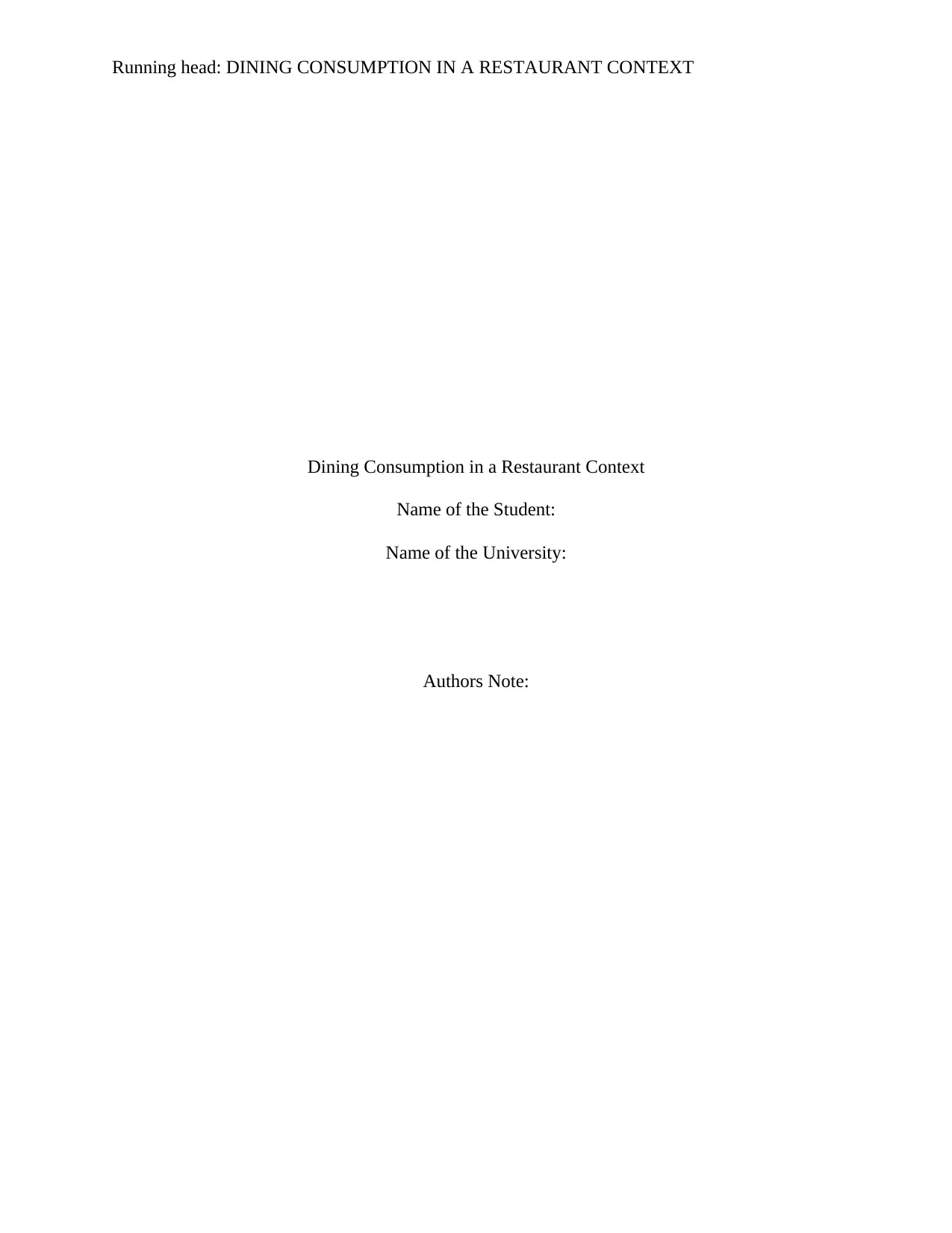
Running head: DINING CONSUMPTION IN A RESTAURANT CONTEXT
Dining Consumption in a Restaurant Context
Name of the Student:
Name of the University:
Authors Note:
Dining Consumption in a Restaurant Context
Name of the Student:
Name of the University:
Authors Note:
Paraphrase This Document
Need a fresh take? Get an instant paraphrase of this document with our AI Paraphraser
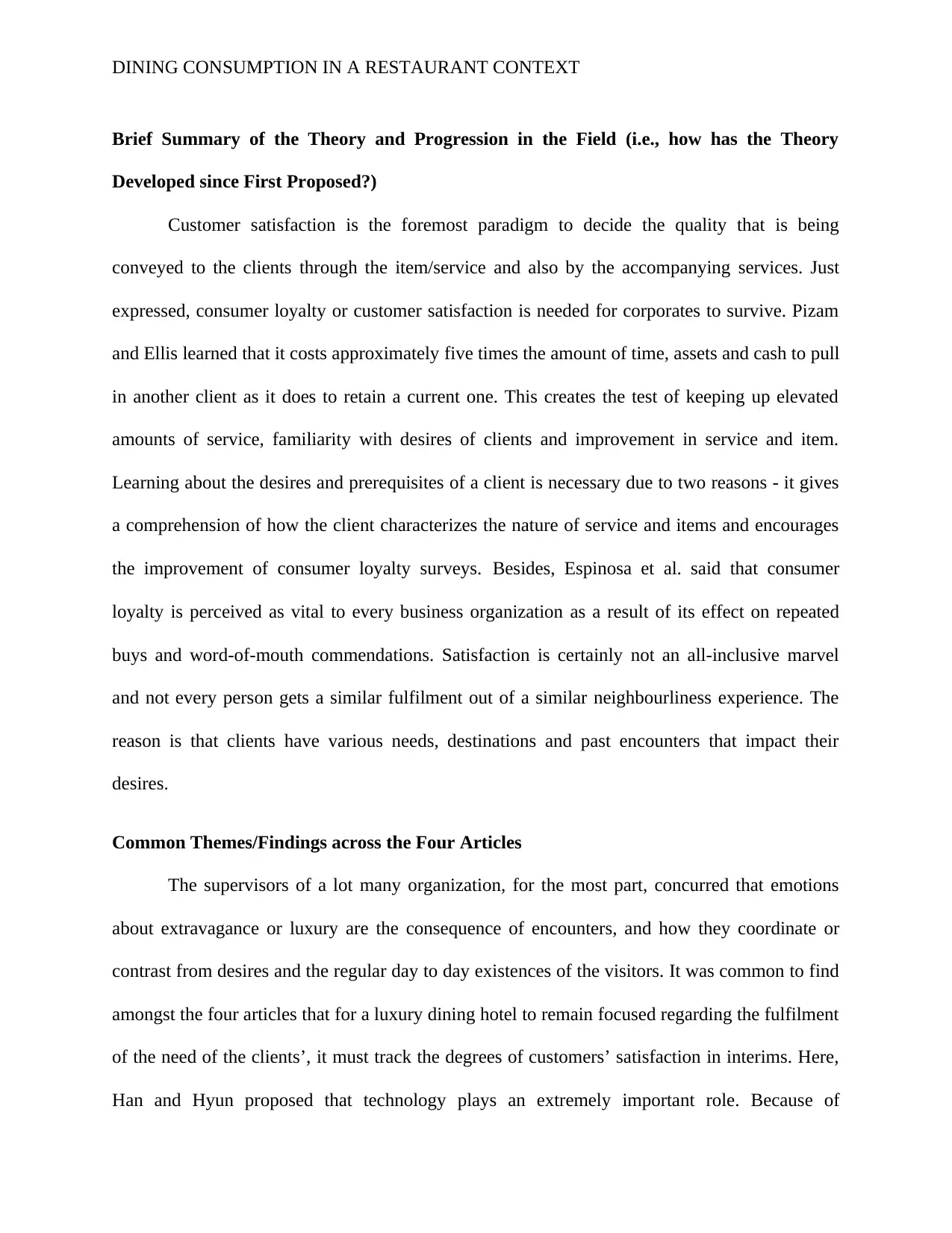
DINING CONSUMPTION IN A RESTAURANT CONTEXT
Brief Summary of the Theory and Progression in the Field (i.e., how has the Theory
Developed since First Proposed?)
Customer satisfaction is the foremost paradigm to decide the quality that is being
conveyed to the clients through the item/service and also by the accompanying services. Just
expressed, consumer loyalty or customer satisfaction is needed for corporates to survive. Pizam
and Ellis learned that it costs approximately five times the amount of time, assets and cash to pull
in another client as it does to retain a current one. This creates the test of keeping up elevated
amounts of service, familiarity with desires of clients and improvement in service and item.
Learning about the desires and prerequisites of a client is necessary due to two reasons - it gives
a comprehension of how the client characterizes the nature of service and items and encourages
the improvement of consumer loyalty surveys. Besides, Espinosa et al. said that consumer
loyalty is perceived as vital to every business organization as a result of its effect on repeated
buys and word-of-mouth commendations. Satisfaction is certainly not an all-inclusive marvel
and not every person gets a similar fulfilment out of a similar neighbourliness experience. The
reason is that clients have various needs, destinations and past encounters that impact their
desires.
Common Themes/Findings across the Four Articles
The supervisors of a lot many organization, for the most part, concurred that emotions
about extravagance or luxury are the consequence of encounters, and how they coordinate or
contrast from desires and the regular day to day existences of the visitors. It was common to find
amongst the four articles that for a luxury dining hotel to remain focused regarding the fulfilment
of the need of the clients’, it must track the degrees of customers’ satisfaction in interims. Here,
Han and Hyun proposed that technology plays an extremely important role. Because of
Brief Summary of the Theory and Progression in the Field (i.e., how has the Theory
Developed since First Proposed?)
Customer satisfaction is the foremost paradigm to decide the quality that is being
conveyed to the clients through the item/service and also by the accompanying services. Just
expressed, consumer loyalty or customer satisfaction is needed for corporates to survive. Pizam
and Ellis learned that it costs approximately five times the amount of time, assets and cash to pull
in another client as it does to retain a current one. This creates the test of keeping up elevated
amounts of service, familiarity with desires of clients and improvement in service and item.
Learning about the desires and prerequisites of a client is necessary due to two reasons - it gives
a comprehension of how the client characterizes the nature of service and items and encourages
the improvement of consumer loyalty surveys. Besides, Espinosa et al. said that consumer
loyalty is perceived as vital to every business organization as a result of its effect on repeated
buys and word-of-mouth commendations. Satisfaction is certainly not an all-inclusive marvel
and not every person gets a similar fulfilment out of a similar neighbourliness experience. The
reason is that clients have various needs, destinations and past encounters that impact their
desires.
Common Themes/Findings across the Four Articles
The supervisors of a lot many organization, for the most part, concurred that emotions
about extravagance or luxury are the consequence of encounters, and how they coordinate or
contrast from desires and the regular day to day existences of the visitors. It was common to find
amongst the four articles that for a luxury dining hotel to remain focused regarding the fulfilment
of the need of the clients’, it must track the degrees of customers’ satisfaction in interims. Here,
Han and Hyun proposed that technology plays an extremely important role. Because of
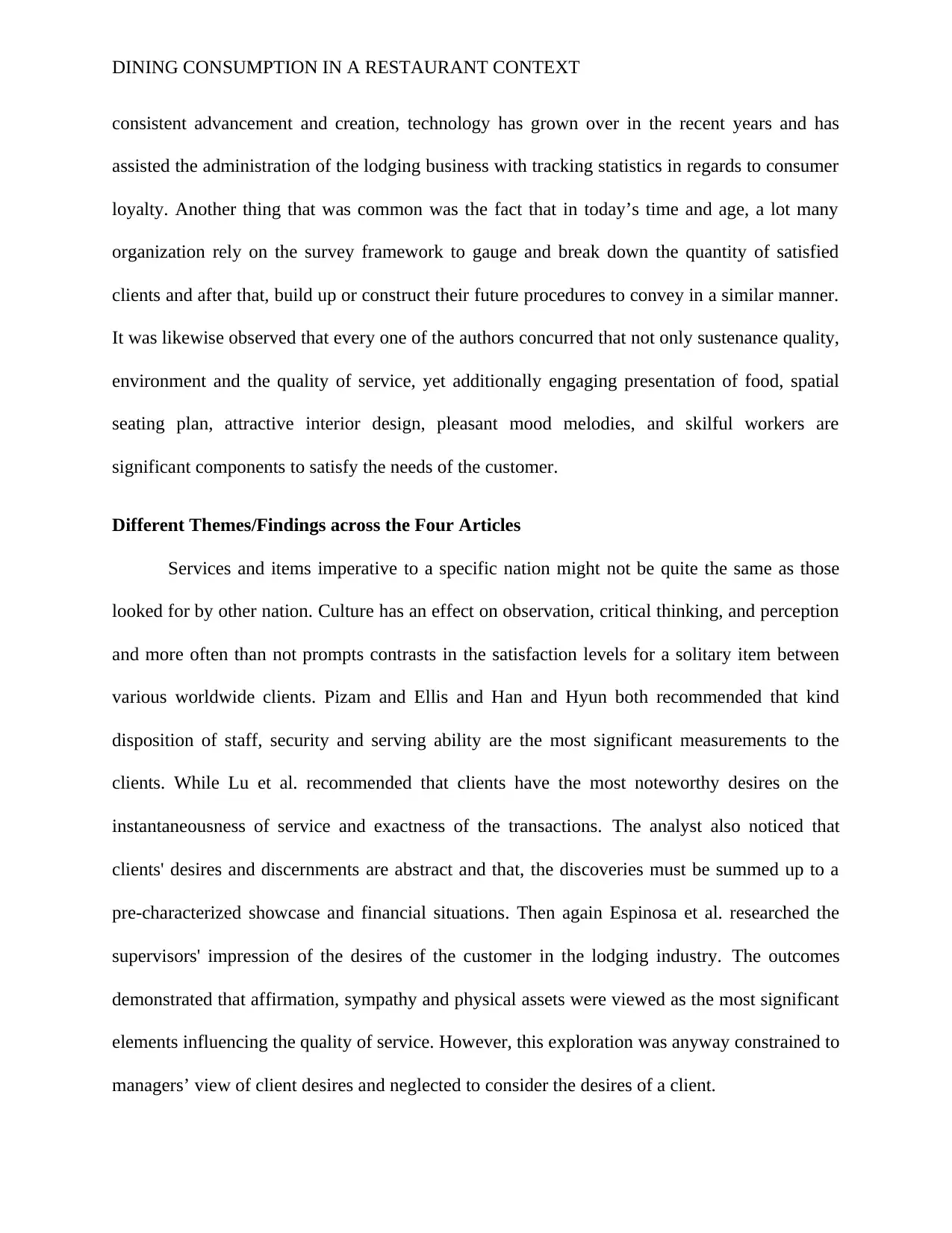
DINING CONSUMPTION IN A RESTAURANT CONTEXT
consistent advancement and creation, technology has grown over in the recent years and has
assisted the administration of the lodging business with tracking statistics in regards to consumer
loyalty. Another thing that was common was the fact that in today’s time and age, a lot many
organization rely on the survey framework to gauge and break down the quantity of satisfied
clients and after that, build up or construct their future procedures to convey in a similar manner.
It was likewise observed that every one of the authors concurred that not only sustenance quality,
environment and the quality of service, yet additionally engaging presentation of food, spatial
seating plan, attractive interior design, pleasant mood melodies, and skilful workers are
significant components to satisfy the needs of the customer.
Different Themes/Findings across the Four Articles
Services and items imperative to a specific nation might not be quite the same as those
looked for by other nation. Culture has an effect on observation, critical thinking, and perception
and more often than not prompts contrasts in the satisfaction levels for a solitary item between
various worldwide clients. Pizam and Ellis and Han and Hyun both recommended that kind
disposition of staff, security and serving ability are the most significant measurements to the
clients. While Lu et al. recommended that clients have the most noteworthy desires on the
instantaneousness of service and exactness of the transactions. The analyst also noticed that
clients' desires and discernments are abstract and that, the discoveries must be summed up to a
pre-characterized showcase and financial situations. Then again Espinosa et al. researched the
supervisors' impression of the desires of the customer in the lodging industry. The outcomes
demonstrated that affirmation, sympathy and physical assets were viewed as the most significant
elements influencing the quality of service. However, this exploration was anyway constrained to
managers’ view of client desires and neglected to consider the desires of a client.
consistent advancement and creation, technology has grown over in the recent years and has
assisted the administration of the lodging business with tracking statistics in regards to consumer
loyalty. Another thing that was common was the fact that in today’s time and age, a lot many
organization rely on the survey framework to gauge and break down the quantity of satisfied
clients and after that, build up or construct their future procedures to convey in a similar manner.
It was likewise observed that every one of the authors concurred that not only sustenance quality,
environment and the quality of service, yet additionally engaging presentation of food, spatial
seating plan, attractive interior design, pleasant mood melodies, and skilful workers are
significant components to satisfy the needs of the customer.
Different Themes/Findings across the Four Articles
Services and items imperative to a specific nation might not be quite the same as those
looked for by other nation. Culture has an effect on observation, critical thinking, and perception
and more often than not prompts contrasts in the satisfaction levels for a solitary item between
various worldwide clients. Pizam and Ellis and Han and Hyun both recommended that kind
disposition of staff, security and serving ability are the most significant measurements to the
clients. While Lu et al. recommended that clients have the most noteworthy desires on the
instantaneousness of service and exactness of the transactions. The analyst also noticed that
clients' desires and discernments are abstract and that, the discoveries must be summed up to a
pre-characterized showcase and financial situations. Then again Espinosa et al. researched the
supervisors' impression of the desires of the customer in the lodging industry. The outcomes
demonstrated that affirmation, sympathy and physical assets were viewed as the most significant
elements influencing the quality of service. However, this exploration was anyway constrained to
managers’ view of client desires and neglected to consider the desires of a client.
⊘ This is a preview!⊘
Do you want full access?
Subscribe today to unlock all pages.

Trusted by 1+ million students worldwide
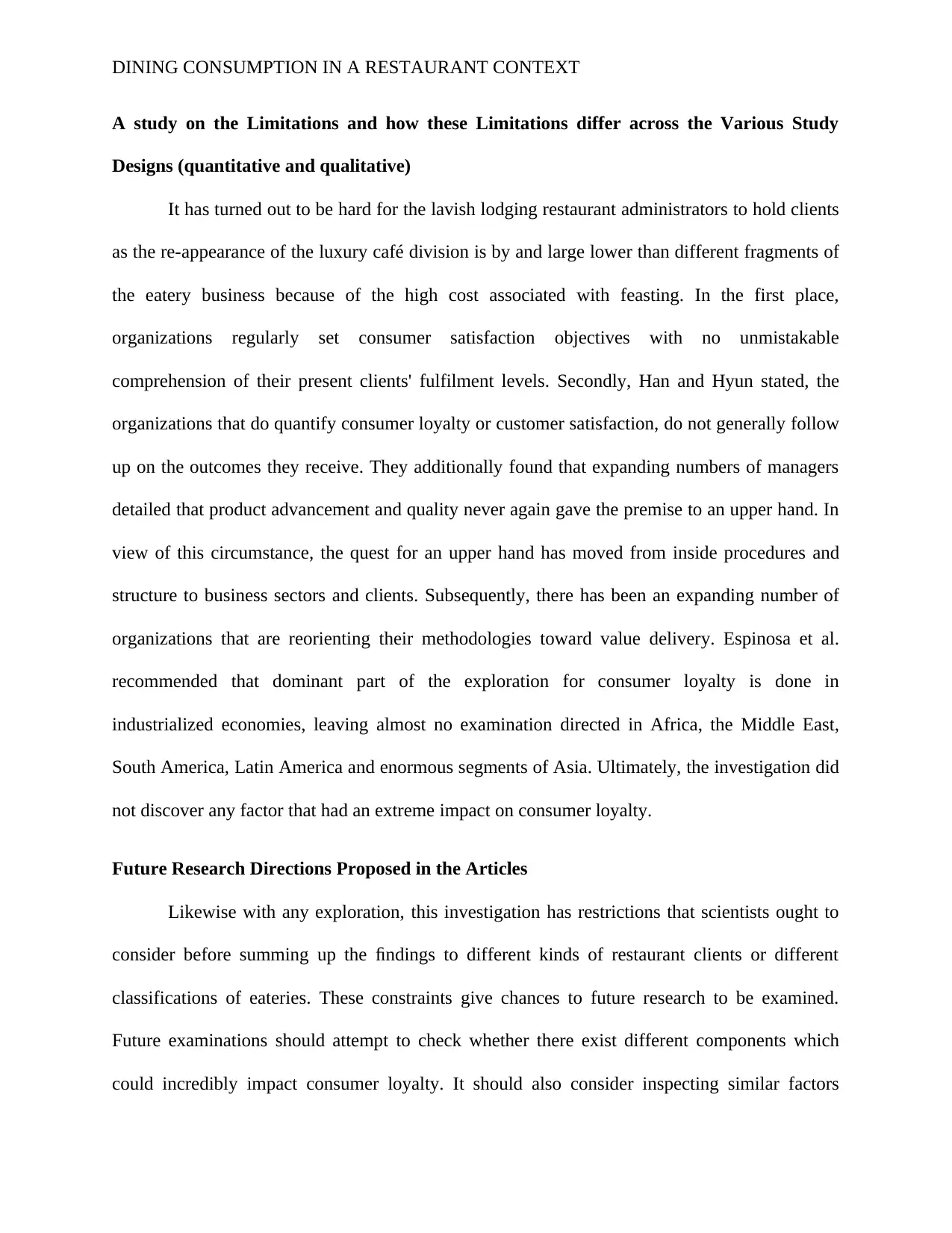
DINING CONSUMPTION IN A RESTAURANT CONTEXT
A study on the Limitations and how these Limitations differ across the Various Study
Designs (quantitative and qualitative)
It has turned out to be hard for the lavish lodging restaurant administrators to hold clients
as the re-appearance of the luxury café division is by and large lower than different fragments of
the eatery business because of the high cost associated with feasting. In the first place,
organizations regularly set consumer satisfaction objectives with no unmistakable
comprehension of their present clients' fulfilment levels. Secondly, Han and Hyun stated, the
organizations that do quantify consumer loyalty or customer satisfaction, do not generally follow
up on the outcomes they receive. They additionally found that expanding numbers of managers
detailed that product advancement and quality never again gave the premise to an upper hand. In
view of this circumstance, the quest for an upper hand has moved from inside procedures and
structure to business sectors and clients. Subsequently, there has been an expanding number of
organizations that are reorienting their methodologies toward value delivery. Espinosa et al.
recommended that dominant part of the exploration for consumer loyalty is done in
industrialized economies, leaving almost no examination directed in Africa, the Middle East,
South America, Latin America and enormous segments of Asia. Ultimately, the investigation did
not discover any factor that had an extreme impact on consumer loyalty.
Future Research Directions Proposed in the Articles
Likewise with any exploration, this investigation has restrictions that scientists ought to
consider before summing up the findings to different kinds of restaurant clients or different
classifications of eateries. These constraints give chances to future research to be examined.
Future examinations should attempt to check whether there exist different components which
could incredibly impact consumer loyalty. It should also consider inspecting similar factors
A study on the Limitations and how these Limitations differ across the Various Study
Designs (quantitative and qualitative)
It has turned out to be hard for the lavish lodging restaurant administrators to hold clients
as the re-appearance of the luxury café division is by and large lower than different fragments of
the eatery business because of the high cost associated with feasting. In the first place,
organizations regularly set consumer satisfaction objectives with no unmistakable
comprehension of their present clients' fulfilment levels. Secondly, Han and Hyun stated, the
organizations that do quantify consumer loyalty or customer satisfaction, do not generally follow
up on the outcomes they receive. They additionally found that expanding numbers of managers
detailed that product advancement and quality never again gave the premise to an upper hand. In
view of this circumstance, the quest for an upper hand has moved from inside procedures and
structure to business sectors and clients. Subsequently, there has been an expanding number of
organizations that are reorienting their methodologies toward value delivery. Espinosa et al.
recommended that dominant part of the exploration for consumer loyalty is done in
industrialized economies, leaving almost no examination directed in Africa, the Middle East,
South America, Latin America and enormous segments of Asia. Ultimately, the investigation did
not discover any factor that had an extreme impact on consumer loyalty.
Future Research Directions Proposed in the Articles
Likewise with any exploration, this investigation has restrictions that scientists ought to
consider before summing up the findings to different kinds of restaurant clients or different
classifications of eateries. These constraints give chances to future research to be examined.
Future examinations should attempt to check whether there exist different components which
could incredibly impact consumer loyalty. It should also consider inspecting similar factors
Paraphrase This Document
Need a fresh take? Get an instant paraphrase of this document with our AI Paraphraser
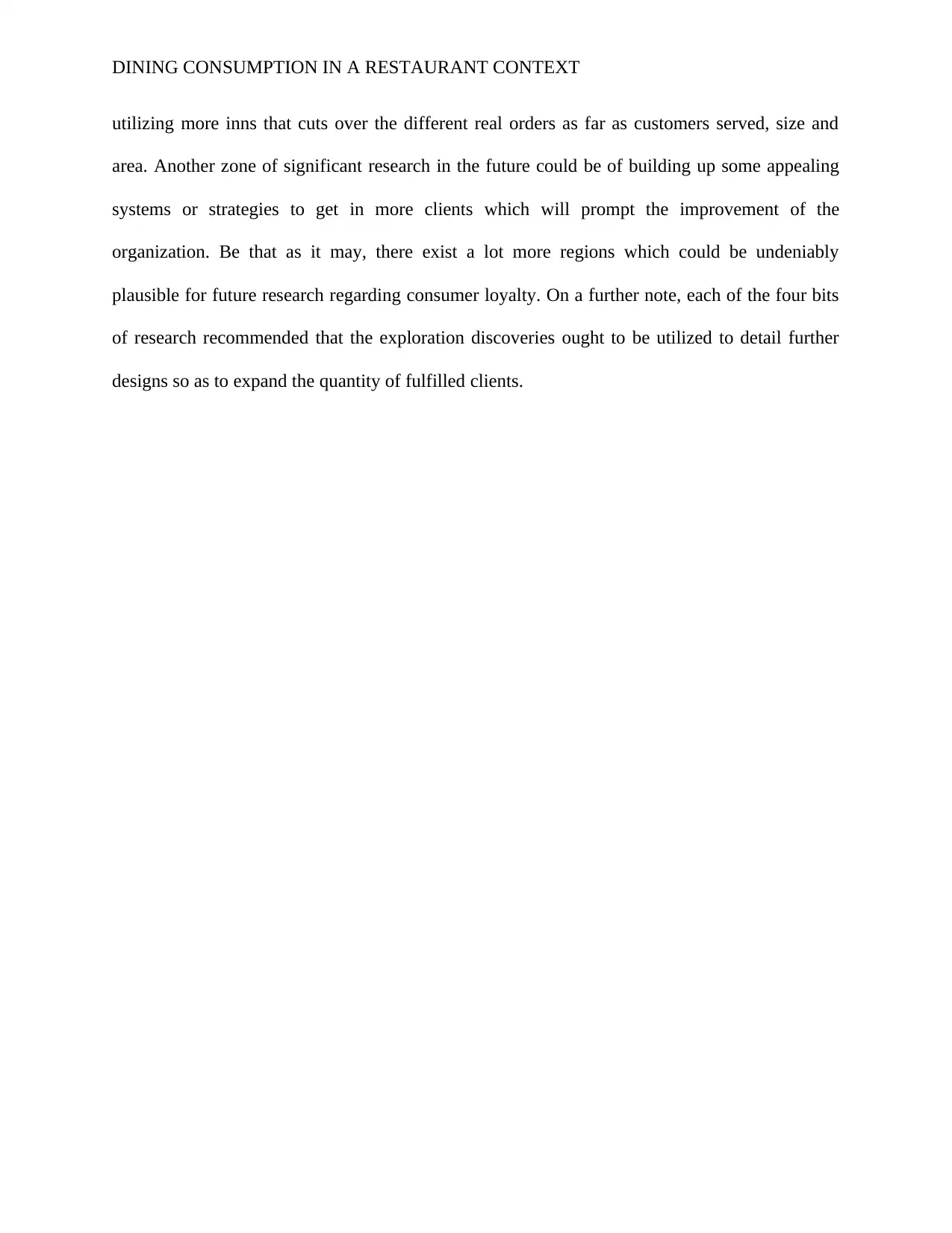
DINING CONSUMPTION IN A RESTAURANT CONTEXT
utilizing more inns that cuts over the different real orders as far as customers served, size and
area. Another zone of significant research in the future could be of building up some appealing
systems or strategies to get in more clients which will prompt the improvement of the
organization. Be that as it may, there exist a lot more regions which could be undeniably
plausible for future research regarding consumer loyalty. On a further note, each of the four bits
of research recommended that the exploration discoveries ought to be utilized to detail further
designs so as to expand the quantity of fulfilled clients.
utilizing more inns that cuts over the different real orders as far as customers served, size and
area. Another zone of significant research in the future could be of building up some appealing
systems or strategies to get in more clients which will prompt the improvement of the
organization. Be that as it may, there exist a lot more regions which could be undeniably
plausible for future research regarding consumer loyalty. On a further note, each of the four bits
of research recommended that the exploration discoveries ought to be utilized to detail further
designs so as to expand the quantity of fulfilled clients.
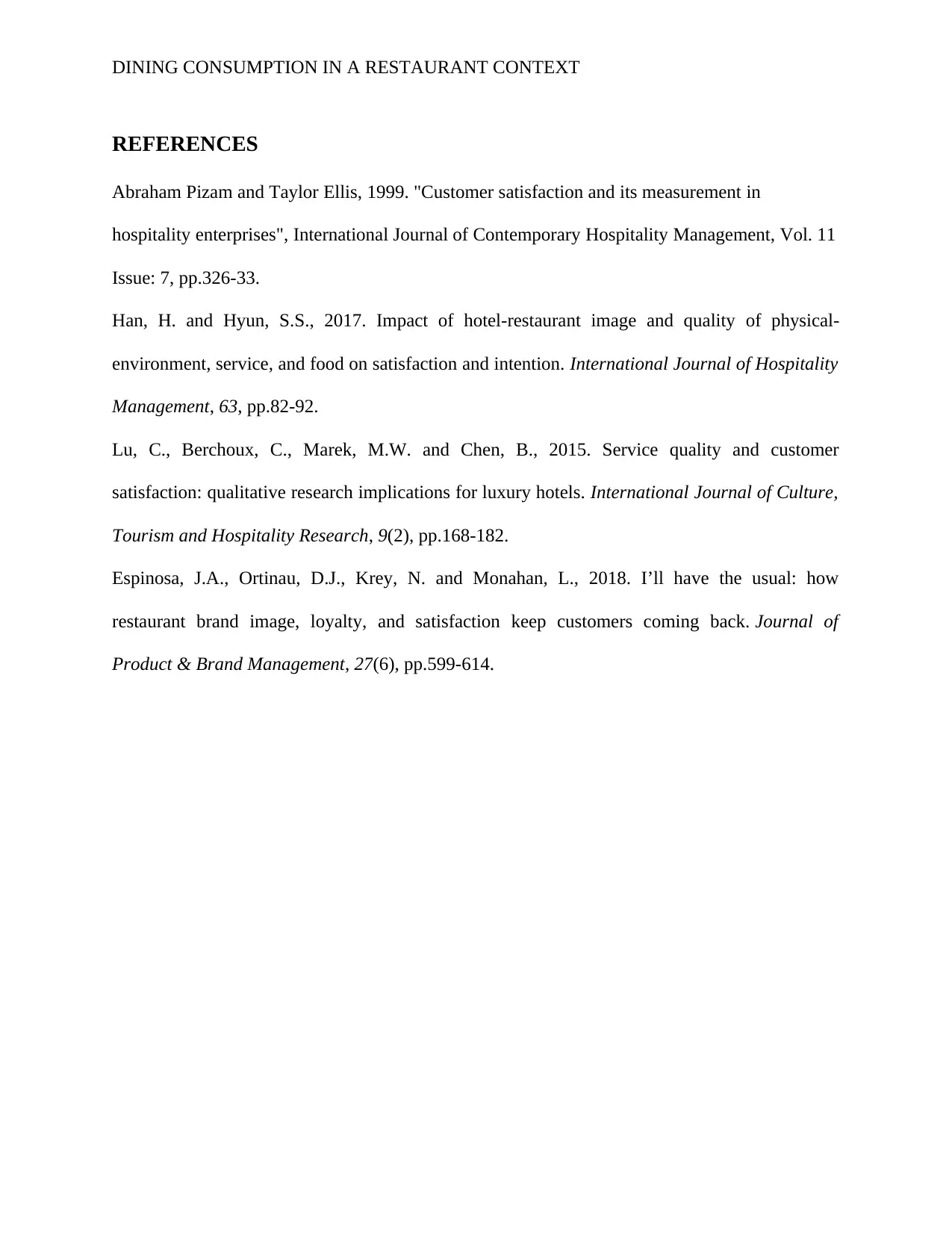
DINING CONSUMPTION IN A RESTAURANT CONTEXT
REFERENCES
Abraham Pizam and Taylor Ellis, 1999. "Customer satisfaction and its measurement in
hospitality enterprises", International Journal of Contemporary Hospitality Management, Vol. 11
Issue: 7, pp.326-33.
Han, H. and Hyun, S.S., 2017. Impact of hotel-restaurant image and quality of physical-
environment, service, and food on satisfaction and intention. International Journal of Hospitality
Management, 63, pp.82-92.
Lu, C., Berchoux, C., Marek, M.W. and Chen, B., 2015. Service quality and customer
satisfaction: qualitative research implications for luxury hotels. International Journal of Culture,
Tourism and Hospitality Research, 9(2), pp.168-182.
Espinosa, J.A., Ortinau, D.J., Krey, N. and Monahan, L., 2018. I’ll have the usual: how
restaurant brand image, loyalty, and satisfaction keep customers coming back. Journal of
Product & Brand Management, 27(6), pp.599-614.
REFERENCES
Abraham Pizam and Taylor Ellis, 1999. "Customer satisfaction and its measurement in
hospitality enterprises", International Journal of Contemporary Hospitality Management, Vol. 11
Issue: 7, pp.326-33.
Han, H. and Hyun, S.S., 2017. Impact of hotel-restaurant image and quality of physical-
environment, service, and food on satisfaction and intention. International Journal of Hospitality
Management, 63, pp.82-92.
Lu, C., Berchoux, C., Marek, M.W. and Chen, B., 2015. Service quality and customer
satisfaction: qualitative research implications for luxury hotels. International Journal of Culture,
Tourism and Hospitality Research, 9(2), pp.168-182.
Espinosa, J.A., Ortinau, D.J., Krey, N. and Monahan, L., 2018. I’ll have the usual: how
restaurant brand image, loyalty, and satisfaction keep customers coming back. Journal of
Product & Brand Management, 27(6), pp.599-614.
⊘ This is a preview!⊘
Do you want full access?
Subscribe today to unlock all pages.

Trusted by 1+ million students worldwide
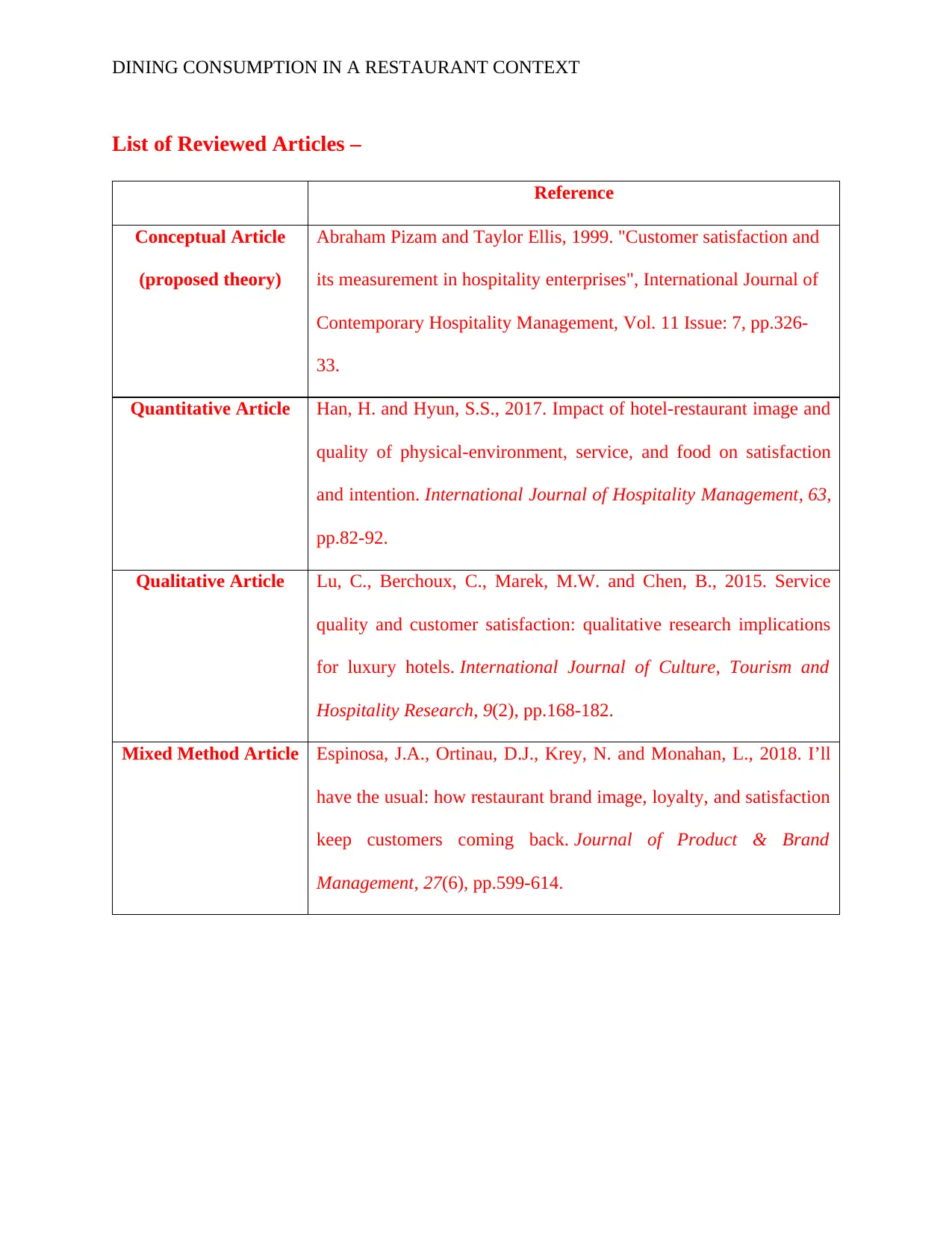
DINING CONSUMPTION IN A RESTAURANT CONTEXT
List of Reviewed Articles –
Reference
Conceptual Article
(proposed theory)
Abraham Pizam and Taylor Ellis, 1999. "Customer satisfaction and
its measurement in hospitality enterprises", International Journal of
Contemporary Hospitality Management, Vol. 11 Issue: 7, pp.326-
33.
Quantitative Article Han, H. and Hyun, S.S., 2017. Impact of hotel-restaurant image and
quality of physical-environment, service, and food on satisfaction
and intention. International Journal of Hospitality Management, 63,
pp.82-92.
Qualitative Article Lu, C., Berchoux, C., Marek, M.W. and Chen, B., 2015. Service
quality and customer satisfaction: qualitative research implications
for luxury hotels. International Journal of Culture, Tourism and
Hospitality Research, 9(2), pp.168-182.
Mixed Method Article Espinosa, J.A., Ortinau, D.J., Krey, N. and Monahan, L., 2018. I’ll
have the usual: how restaurant brand image, loyalty, and satisfaction
keep customers coming back. Journal of Product & Brand
Management, 27(6), pp.599-614.
List of Reviewed Articles –
Reference
Conceptual Article
(proposed theory)
Abraham Pizam and Taylor Ellis, 1999. "Customer satisfaction and
its measurement in hospitality enterprises", International Journal of
Contemporary Hospitality Management, Vol. 11 Issue: 7, pp.326-
33.
Quantitative Article Han, H. and Hyun, S.S., 2017. Impact of hotel-restaurant image and
quality of physical-environment, service, and food on satisfaction
and intention. International Journal of Hospitality Management, 63,
pp.82-92.
Qualitative Article Lu, C., Berchoux, C., Marek, M.W. and Chen, B., 2015. Service
quality and customer satisfaction: qualitative research implications
for luxury hotels. International Journal of Culture, Tourism and
Hospitality Research, 9(2), pp.168-182.
Mixed Method Article Espinosa, J.A., Ortinau, D.J., Krey, N. and Monahan, L., 2018. I’ll
have the usual: how restaurant brand image, loyalty, and satisfaction
keep customers coming back. Journal of Product & Brand
Management, 27(6), pp.599-614.
1 out of 7
Related Documents
Your All-in-One AI-Powered Toolkit for Academic Success.
+13062052269
info@desklib.com
Available 24*7 on WhatsApp / Email
![[object Object]](/_next/static/media/star-bottom.7253800d.svg)
Unlock your academic potential
Copyright © 2020–2025 A2Z Services. All Rights Reserved. Developed and managed by ZUCOL.





